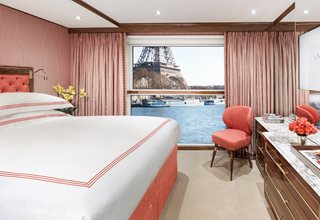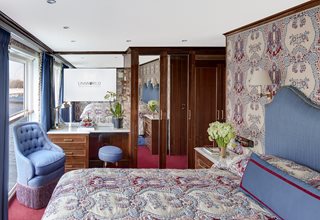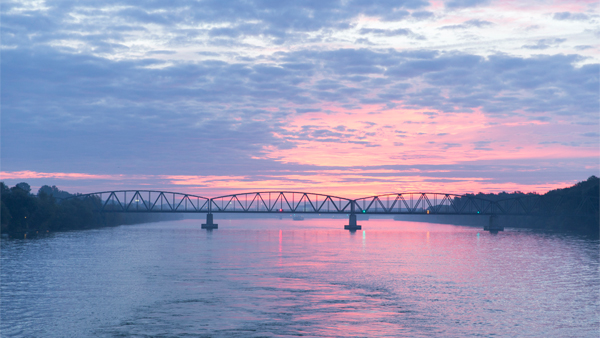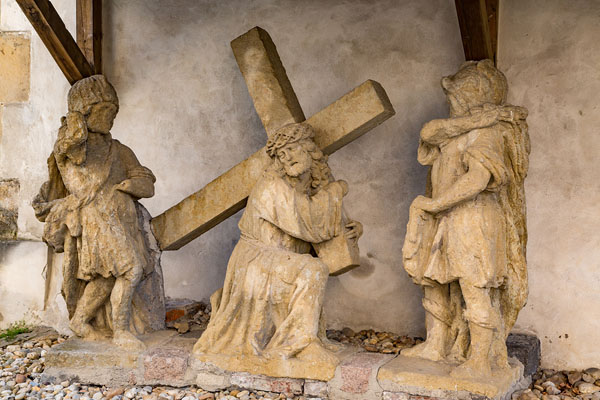
Europe and Mediterranean: Vineyards & Palaces Along the Danube Cruise
Uniworld Boutique River Cruises
Every bend of the Danube brings new delights. Dramatic hills rise and manicured vineyards line the riverbanks. Pretty villages beckon with medieval architecture and celebrated wineries. Majestic palaces and historic castles harken to the imperial grandeur. This journey brings each of these elements together into one breathtaking river cruise.

True All-Inclusive Boutique River Cruising™
All gratuities for onboard services
Unlimited fine wine, beer, spirits and nonalcoholic beverages**
Shore excursions with local experts as your guide
Internet and Wi-Fi
All arrival and departure day transfers
Executive Member Benefit
Executive Members receive an annual 2% Reward, up to $1,250, on qualified Costco Travel purchases
Receive a $50 shipboard credit per person (maximum $100 per stateroom)♦
Digital Costco Shop Card
Member Exclusive: Digital Costco Shop Card with every Uniworld river cruise†
Sailing Itinerary

Note: Cruise itineraries are subject to change. Please verify ports and times directly with the cruise line.
Overview
Today, Vienna is once again in the center of Europe. But not so long ago, Vienna was just on the western side of the Iron Curtain. Many visitors are surprised to learn that Vienna is further east than Prague and Berlin.Vienna was once the heart of a vast realm, the Habsburg Empire. For a time, the possessions of the Habsburgs, who ruled for more than 600 years, were so far-flung that it was said that the sun never set on its dominions. All that came to an end more than 80 years ago. Today, Austria is a small country of about eight million people. But Vienna still has heart. It is one of the most comfortable, interesting, beautiful capital cities in the world.The Vienna of today is a modern, international metropolis in the heart of Central Europe, a city with a quality lifestyle and an embraceable joy for living. Vienna caters to your needs in terms of education, social, and health services and also offers a wide range of leisure and cultural activities.
Overview
Today, Vienna is once again in the center of Europe. But not so long ago, Vienna was just on the western side of the Iron Curtain. Many visitors are surprised to learn that Vienna is further east than Prague and Berlin.Vienna was once the heart of a vast realm, the Habsburg Empire. For a time, the possessions of the Habsburgs, who ruled for more than 600 years, were so far-flung that it was said that the sun never set on its dominions. All that came to an end more than 80 years ago. Today, Austria is a small country of about eight million people. But Vienna still has heart. It is one of the most comfortable, interesting, beautiful capital cities in the world.The Vienna of today is a modern, international metropolis in the heart of Central Europe, a city with a quality lifestyle and an embraceable joy for living. Vienna caters to your needs in terms of education, social, and health services and also offers a wide range of leisure and cultural activities.
Overview
The popular recreational village Spitz is situated at the left bank of the Danube in the heart of the Wachau. Built around the so-called "Thousand-bucket-hill", wine grows right in the middle of the village. The ancient wine growers’ village with its Renaissance and Baroque houses and the beautiful square in front of the late-gothic church of the 15th century invites you for a stay. In terrace form, the vineyards surround the village. With its 50 km of marked hiking paths and its 2 km long Danube promenade, Spitz forms the ideal starting point for hiking tours into the Wachau, the Waldviertel, and the Dunkelsteiner woods. Our village lies directlyont the Danube cycle trail.
Overview
The town on the three rivers – the Danube, the Inn, and the Ilz – got its name from the Roman fort of Batavia. After 739 AD Passau grew to become the biggest bishopric on the Danube, its domain extending to Hungary. After the great fire of 1662, the prince bishops rebuilt the town in the Baroque style. One of the highlights of the Old Town is the beautiful Cathedral of St Stephan, which boasts the biggest church organ in the world. High up above the town and the rivers stand the Veste Oberhaus Castle and the Maria Hilf Abbey, both of which are also well worth a visit.
Overview
Deggendorf is a town in Bavaria, the capital of the district Deggendorf. The earliest traces of settlement in the area are found near the Danube, about 8,000 years ago.
Overview
Regensburg is widely regarded as the medieval wonder of Germany – a historic city in a unique state of preservation, living witness to two thousand years of rich and colorful history. At every turn, one encounters truly outstanding historical monuments and architectural marvels. The experience is deepened by the exquisite collections at the city’s fine museums and made yet more enjoyable by the typically warm Bavarian hospitality of the locals. Located on the beautiful Danube, Regensburg is also the perfect sstarting placefor river cruises and excursions.
Overview
Nuremberg is the largest city in Franconia and the natural centre of North Bavaria. In terms of population it is the second largest city in Bavaria and the thirteenth largest in Germany. Together with its neighbours Fürth, Erlangen, Schwabach and the surrounding rural districts, Nuremberg is part of one of Europe’s most important economic areas, where the EU and its Eastern neighbours meet. Nuremberg is surrounded by attractive landscapes: to the East the Franconian hills, to the North "Franconian Switzerland" and to the South-West the Franconian Lakes. Centuries of art and architecture made Nuremberg a treasure. During the 15th and 16th centuries, Nuremberg enjoyed a cultural flowering that made it the center of the German Renaissance, bringing together Italian Renaissance and German Gothic traditions. In the artists' workshops were found such great talents as Veit Stoss, Peter Vischer, Adam Krafft, Michael Wolgemut, and above all, Albrecht Dürer. Koberger set up his printing press here, and Regiomontanus built an astronomical observatory. Here, too, flourished the guilds of the Meistersingers, composed of prosperous artisans; Wagner made their most famous member, Hans Sachs, the hero of his opera Die Meistersinger von Nuremberg. Many of Nuremberg's most important buildings, including some of the finest churches in Germany, have been restored or reconstructed. The old part of the city, the Altstadt, lies mainly within a pedestrian zone. Today's visitors can see the ruins of the ramparts that once surrounded the city as well as more modern sites, such as the Justice Palace, where the War Crimes Tribunal sat in 1946. Visitors can also see the Zeppelinfeld arena, the huge amphitheater where, from 1927 to 1935, Hitler staged those dramatic Nazi rallies that were immortalized by Leni Riefenstahl in Triumph des Willens (Triumph of the Will). Hitler's architect, Albert Speer, constructed what has been called a "concrete mecca," whose grounds today have been turned into a park with apartment blocks, a trade fair, and a concert hall. Speer's Congress Hall, larger than the Colosseum in Rome, has become a recording studio and warehouse.
Overview
Nuremberg is the largest city in Franconia and the natural centre of North Bavaria. In terms of population it is the second largest city in Bavaria and the thirteenth largest in Germany. Together with its neighbours Fürth, Erlangen, Schwabach and the surrounding rural districts, Nuremberg is part of one of Europe’s most important economic areas, where the EU and its Eastern neighbours meet. Nuremberg is surrounded by attractive landscapes: to the East the Franconian hills, to the North "Franconian Switzerland" and to the South-West the Franconian Lakes. Centuries of art and architecture made Nuremberg a treasure. During the 15th and 16th centuries, Nuremberg enjoyed a cultural flowering that made it the center of the German Renaissance, bringing together Italian Renaissance and German Gothic traditions. In the artists' workshops were found such great talents as Veit Stoss, Peter Vischer, Adam Krafft, Michael Wolgemut, and above all, Albrecht Dürer. Koberger set up his printing press here, and Regiomontanus built an astronomical observatory. Here, too, flourished the guilds of the Meistersingers, composed of prosperous artisans; Wagner made their most famous member, Hans Sachs, the hero of his opera Die Meistersinger von Nuremberg. Many of Nuremberg's most important buildings, including some of the finest churches in Germany, have been restored or reconstructed. The old part of the city, the Altstadt, lies mainly within a pedestrian zone. Today's visitors can see the ruins of the ramparts that once surrounded the city as well as more modern sites, such as the Justice Palace, where the War Crimes Tribunal sat in 1946. Visitors can also see the Zeppelinfeld arena, the huge amphitheater where, from 1927 to 1935, Hitler staged those dramatic Nazi rallies that were immortalized by Leni Riefenstahl in Triumph des Willens (Triumph of the Will). Hitler's architect, Albert Speer, constructed what has been called a "concrete mecca," whose grounds today have been turned into a park with apartment blocks, a trade fair, and a concert hall. Speer's Congress Hall, larger than the Colosseum in Rome, has become a recording studio and warehouse.
Onboard the S.S. Emilie
S.S. Emilie
Year Built: 2026
Double Occupancy Capacity: 154
Sailing the Danube River, the next member of Uniworld’s Super Ship™ fleet will be inspired by master Viennese painter Gustav Klimt. In his honor, the vessel is named after his beloved muse, Emilie Flöge. When she debuts in 2026, the S.S. Emilie will bring elements of Klimt’s signature style to guests, with dramatic hues, Art Nouveau elements, and stunning pops of gold. Guests who book a Grand Suite and the adjoining Deluxe French Balcony next door can see their stateroom transformed into an incredibly spacious 2-bedroom suite.
Activities & Services (included in cruise)

Fitness Lounge
- Movies
- Fitness Center
- Fitness Classes
- Culinary Arts Center
- Educational Programs
- Guest Lecturers
- Complimentary Bicycles
- Bars/Lounges
- Onboard Entertainment
- Complimentary Wi-Fi
- Organized Age Specific Activities
- Concierge Desk
- Elevators
- Safe Deposit Boxes
- Self-Service Laundromat
Activities & Services (available for an extra fee)

Spa
- Full-Service Spa
- Spa Services/Massage
- Dry Cleaning/ Laundry Service
- Duty-Free Shops/Boutiques
- Wedding/Vow Renewal

Gustav's Restaurant
Main Dining
Gustav's Restaurant: A great meal is a feast for all the senses and that starts from the moment you step into the dining room. Recline in utmost comfort on smooth velvet seating, bask in the warm glow of a room filled with golden hues and savor delicious dishes farm-to-table cuisine prepared by award-winning chefs.
All staterooms have Open-Air Balconies that, with the touch of a button, will lower the glass halfway to create a balcony-like effect. Adjoining staterooms are available; please inquire at the time of booking. While this is a beautiful and luxurious ship, its amenities may differ slightly from those of a Uniworld-company-owned ship.

Category: FB
In-suite butler service, packing and unpacking assistance, in-room breakfast, daily fruit and cookie plate and an elegant evening snack, espresso machine and fine teas, fully stocked mini bar, bottle of wine upon request, shoeshine, and free laundry service.

Category: S

| Symbol | Description |
|---|

- Ship Name: S.S. Emilie
- Year Built: 2026
- Year Entered Present Fleet: 2026
- Ship Class: River Super Ship
- Maximum Capacity: 154
- Number of Passenger Decks: 3
- Number of Crew: 57
- Officers' Nationality: European/International
- Ocean-View without Balcony: 55
- Ocean-View with Balcony: 10
- Capacity Based on Double Occupancy: 154
- Country of Registry: Switzerland
- Total Staterooms: 77
- Suites with Balcony: 12
- Crew/Hotel Staff Nationality: European/International
Available Dates & Prices
Terms & Conditions
*Price shown is per person based on double occupancy, is valid for select stateroom categories only, and does not include government taxes/fees and gratuities. Click on the Terms & Conditions link below for details.
**Unlimited beverages include premium wine and premium spirits. Diamond List of wine and spirits is available at an additional cost.
♦Executive Members receive a $50 shipboard credit per person, maximum $100 per stateroom. Executive Member benefit is valid for primary cardholder only. Shipboard credit is per stateroom based on double occupancy. Shipboard credit will be applied to your onboard account. Any unused portion of the credit is nontransferable, nonrefundable and may not be redeemed for cash.
†One Digital Costco Shop Card per room/stateroom, per stay. The exact amount of the Digital Costco Shop Card will be calculated during the booking process. The Digital Costco Shop Card promotion is nontransferable and may not be combined with any other promotion. A Digital Costco Shop Card will arrive by email approximately 10 days after the start of your cruise. Click on the Terms & Conditions link below for additional information.
Country of Registry: Switzerland
Digital Costco Shop Card
Book this vacation or cruise with Costco Travel and receive a Digital Costco Shop Card. The Digital Costco Shop Card is a convenient payment option in our warehouses and on Costco.com.















